Edwin C Wells IV
Professor Heart
ODU
ENGL231C
Reflective Letter
This semester started with a reflection of my experience as a writer and reader in the sciences up to this point in my life. I realized that I had only ever written for assignments and not as part of the advancement of the scientific process. Over this course I have realized the importance of why scientists must go through this process of review, propose, and report. At first glance, this process can seem redundant and quite tedious at the best of times. It does make the participants of the process thoroughly organize and examine their testing process and impacts.
This process has been time worn and proven to be a significant advancement in what we call the scientific process. This is because of the communication that must happen between all scientists. Communication is a hard process for even a few people in a room and scientific advancement is a room the size of the planet with multiple conversations going on at the same time. This standardized pathway of review, propose, and report makes navigation of the worldwide conversation easier. It is easier to find information and to have a significant impact on the topic as well.
My growth has really been with the understanding of the process for how scientific research reports and journals come to fruition. I knew that there was a lot of research and some testing for an experiment or study. I was not aware of the process in between with proposals and progress reports. These steps do make sense because a researcher must convince a group of individuals that their research will be of significance and not a waste of time and resources. It also makes sense that those who are paying for the study want to know how their money is being spent.
Final Research Report
Baseline Resource Discovery in Fog Computing in Real World Environment
Edwin C Wells IV
Old Dominion University
English 231C
Professor Heart
Abstract
In recent years, an increasing number of devices are being interconnected with each other and to the internet, this has come to be known as the Internet of Things (IOT). The IOT is also connected to Cloud based servers for various computational tasks and applications. There have been many studies conducted for how best to discover and distribute resources in the fog layer of IOT. However, these studies have major limitations in real world applications with only simulation performed, a central topology, and scalability. Utilizing a distributed based organization methodology with a P2P overlay for fog nodes to discover and remember one another. Monitoring various factors including latency times, task completion rates, fog node task loading, and network usage. Our analysis shows that a distributed topology for fog networking in a real-world environment can and does work outside of simulations. This proof-of-concept testing shows that it can be done and a common baseline for future endeavors can be set.
Introduction
In recent years, an increasing number of devices are being interconnected with each other and to the internet, this has come to be known as the Internet of Things (IOT). The IOT is also connected to Cloud based servers for various computational tasks and applications. The difficulties that come with Cloud processing are high latency, inefficient processing, and ineffective resource management [4]. To address these deficiencies, the fog computing paradigm has been developed to bring resources closer to the end devices [9]. The Fog computing paradigm is a relatively new concept, and the question becomes what is the best way to organize and distribute resources to the end user?
Background
The purpose of our project is to develop and display efficient resource distribution from already existing infrastructure in a city environment. There have been many studies conducted for how best to discover and distribute resources in the fog layer of IOT. However, these studies have major limitations in real world applications. Firstly, is that all the studies are computer simulations and no real-world studies have been conducted thus far. Secondly, many studies are conducted with a centralized topological organization. This organization is inaccurate for how resources are currently distributed and has the single point of failure issue to be resolved as well. Lastly, resource discovery needs to be scalable and easily able to find new processing nodes as they come into the system.
METHODOLOGY
Utilizing a distributed based organization methodology with a P2P overlay for fog nodes to discover and remember one another. Afterwards, created simple augmented reality and point of interest recognitions applications, for volunteers to use, testing high computation and time sensitive requests [6,9,12].
Testing the efficacy of discovery and quality of service for the end users in live environments we utilized already established fog-based infrastructure from three different companies covering the Hampton Roads area. These companies were Amazon, Google, and AT&T. This distribution allowed testing participants to go about their average daily activities. Monitoring various factors including latency times, task completion rates, fog node task loading, and network usage. Periodically removing or adding servers throughout the testing time to simulate the addition or removal of resources that occur in real-world environment. We simulated power outage, nodes leaving the area, and new nodes coming into the area.
Utilizing a P2P network overlay on already established infrastructure allowed the network to self-organize, share resources, distribute resources, distribute control, and symmetric communication [11]. This approach also allows for better scalability as the system demands, reduces the risk for single points of failure, and allow easier discovery of new resources.
RESULTS
In this section, we show the performance of our real-world applications when compared to baseline simulations.
LATENCY TIMES
In our testing we displayed a range from 1 ms at its shortest to 100 ms at its longest for latency. This span is well within expected and similar ranges to other simulations. The range is due to differing network loads at times and complexity of computations.
TASK COMPLETION RATES
Our testing displays a 95% completion rate of tasks before timing out for requests. This value is a bit lower than anticipated when compared to simulations. This could be due to the nature of the infrastructure as it was borrowed from companies. Also, that the applications used to monitor traffic are simple in nature and service resources.
FOG NODE TASK LOADING
We did not have direct control over loading of the network due to simulating what real individuals would use daily. Participants were asked to utilize given applications daily within their average routine. There were periods of load surging and rest. During the surges it was noted that latency times and completion rates were at their lowest.
NETWORK USAGE
As we did not have full control over loading from the user end, we did express control over the network. Adding and removing fog node servers to simulate real world events of power outage and moving resources in and out of the network. These changes happened on a scheduled time frame to note how it would affect task loading, task completion, and latency times. The results were as expected when the network had more resources to use and share all metrics improved. However, the opposite is true as well when fewer resources were available resulting in decreased performance especially during surges.
Discussion
Our analysis shows that a distributed topology for fog networking in a real-world environment can and does work outside of simulations. This testing also shows that it is comparable to computer simulations as well. However, not having control of task loading proved to be a real challenge in anticipation of network surges. Scalability and availability will continue to be complex issues to resolve in the future. This proof-of-concept testing shows that it can be done and a common baseline for future endeavors can be set.
References
1. Adibi E, Khaneghah EM. 2021. A mathematical model to describe resource discovery failure in distributed exascale computing systems. Peer-to-Peer Networking and Applications. 14(3):1021–1043. doi:10.1007/s12083-020-01067-1.
2. Cozzolino V, Ott J, Ding AY, Mortier R. ECCO: Edge-cloud chaining and orchestration framework for road context assessment. In: 2020 IEEE/ACM Fifth International Conference on Internet-of-Things Design and Implementation (IoTDI). IEEE; 2020.
3. Daoud WB, Obaidat MS, Meddeb-Makhlouf A, Zarai F, Hsiao K-F. TACRM: trust access control and resource management mechanism in fog computing. Human-centric computing and information sciences. 2019;9(1). http://dx.doi.org/10.1186/s13673-019-0188-3. doi:10.1186/s13673-019-0188-3
4. Donassolo B, Fajjari I, Legrand A, Mertikopoulos P. Fog based framework for IoT service provisioning. In: 2019 16th IEEE Annual Consumer Communications & Networking Conference (CCNC). IEEE; 2019.
5. Etemadi M, Ghobaei-Arani M, Shahidinejad A. A cost-efficient auto-scaling mechanism for IoT applications in fog computing environment: a deep learning-based approach. Cluster computing. 2021;24(4):3277–3292. http://dx.doi.org/10.1007/s10586-021-03307-2. doi:10.1007/s10586-021-03307-2
6. Gedeon J, Zengerle S, Alles S, Brandherm F, Muhlhauser M. Sunstone: Navigating the way through the fog. In: 2020 IEEE 4th International Conference on Fog and Edge Computing (ICFEC). IEEE; 2020.
7. Javaid S, Javaid N, Saba T, Wadud Z, Rehman A, Haseeb A. Intelligent resource allocation in residential buildings using consumer to fog to cloud based framework. Energies. 2019;12(5):815. http://dx.doi.org/10.3390/en12050815. doi:10.3390/en12050815
8. Kalantary S, Akbari Torkestani J, Shahidinejad A. 2021 May 3. Resource discovery in the Internet of Things integrated with fog computing using Markov learning model. The Journal of Supercomputing. doi:10.1007/s11227-021-03824-2.
9. Papathanail G, Fotoglou I, Demertzis C, Pentelas A, Sgouromitis K, Papadimitriou P, Spatharakis D, Dimolitsas I, Dechouniotis D, Papavassiliou S. COSMOS: An orchestration framework for smart computation offloading in edge clouds. In: NOMS 2020 – 2020 IEEE/IFIP Network Operations and Management Symposium. IEEE; 2020.
10. Santos J, Wauters T, Volckaert B, De Turck F. Fog computing: Enabling the management and orchestration of smart city applications in 5G networks. Entropy (Basel, Switzerland). 2017;20(1):4. http://dx.doi.org/10.3390/e20010004. doi:10.3390/e20010004
11. Shukla, N., Gandhi, C. (2021). Efficient Resource Discovery and Sharing Framework for Fog Computing in Healthcare 4.0. In: Tanwar, S. (eds) Fog Computing for Healthcare 4.0 Environments. Signals and Communication Technology. Springer, Cham. https://doi.org/10.1007/978-3-030-46197-3_16
12. Tocze K, Nadjm-Tehrani S. ORCH: Distributed orchestration framework using mobile edge devices. In: 2019 IEEE 3rd International Conference on Fog and Edge Computing (ICFEC). IEEE; 2019.
13. Zavodovski A, Mohan N, Bayhan S, Wong W, Kangasharju J. ExEC: Elastic extensible edge cloud. In: Proceedings of the 2nd International Workshop on Edge Systems, Analytics and Networking – EdgeSys ’19. New York, New York, USA: ACM Press; 2019.
PowerPoint Presentation
Slide 1
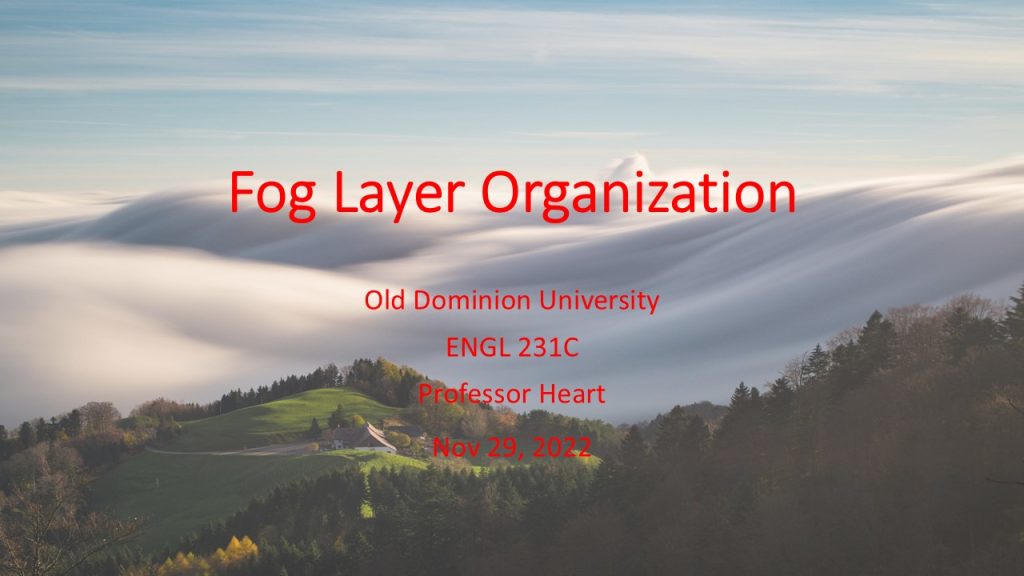
Slide 2
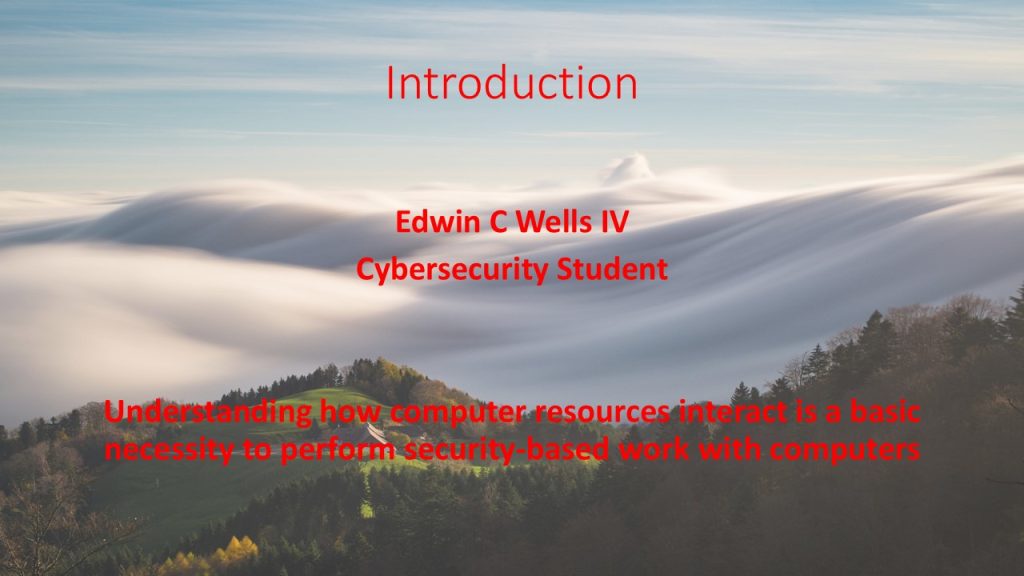
Slide 3
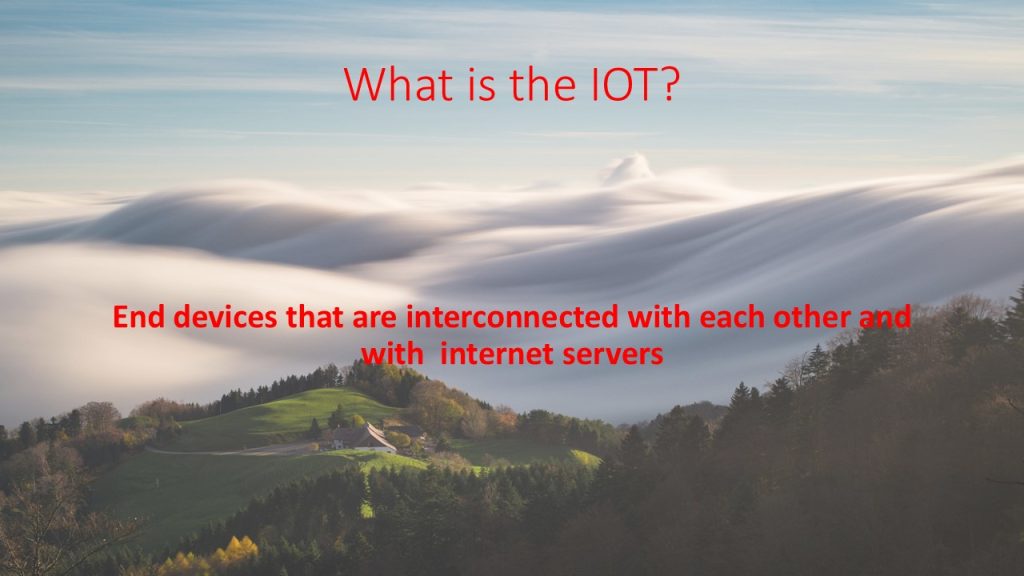
Slide 4

Slide 5
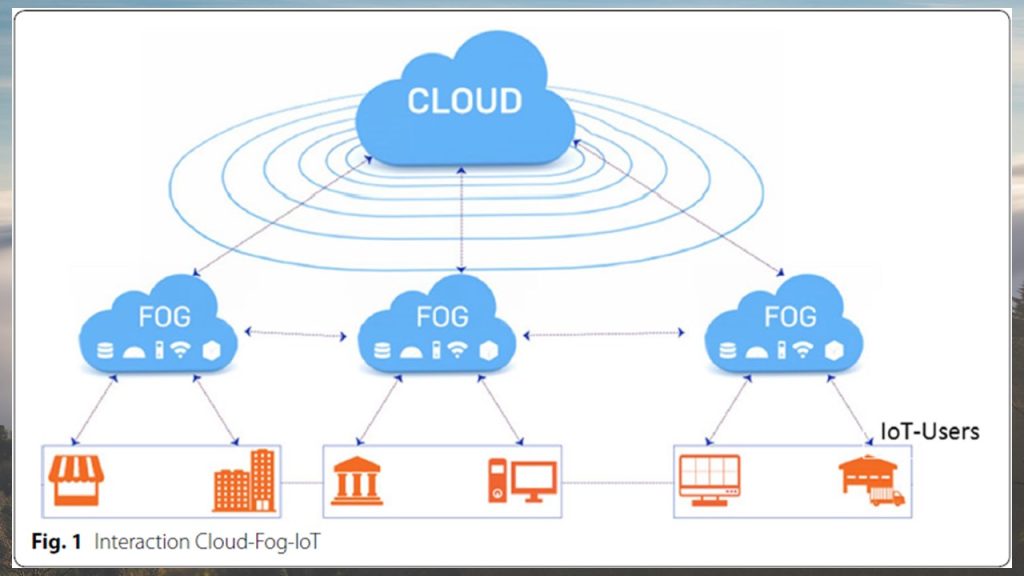
Slide 6

Slide 7
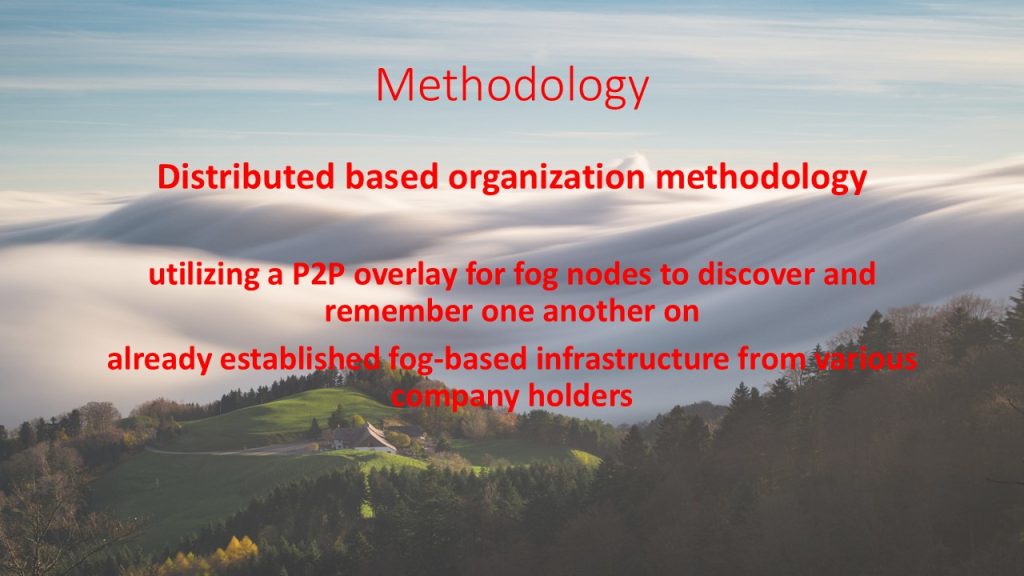
Slide 8
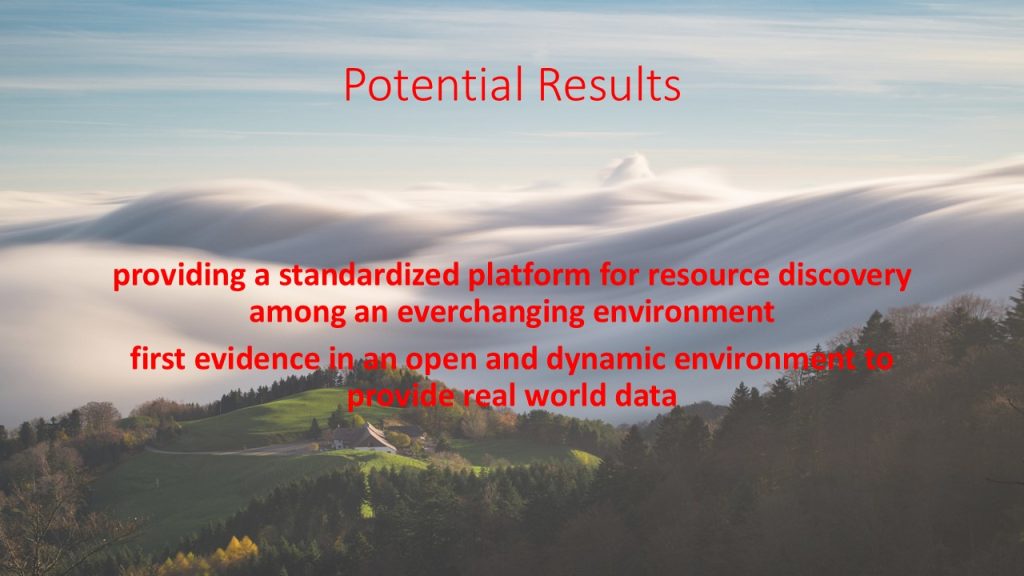
Slide 9
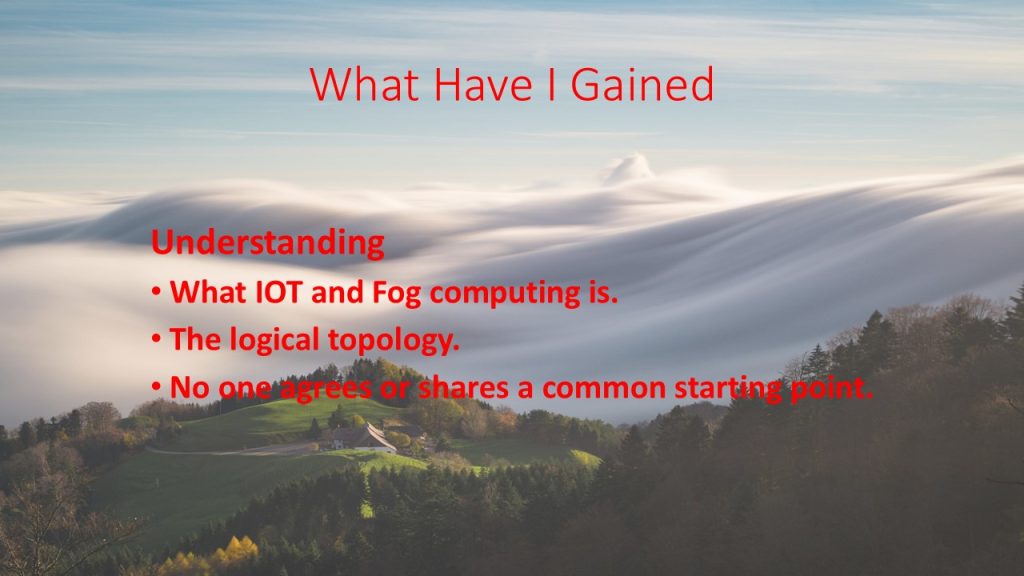
Slide 10

Slide 11
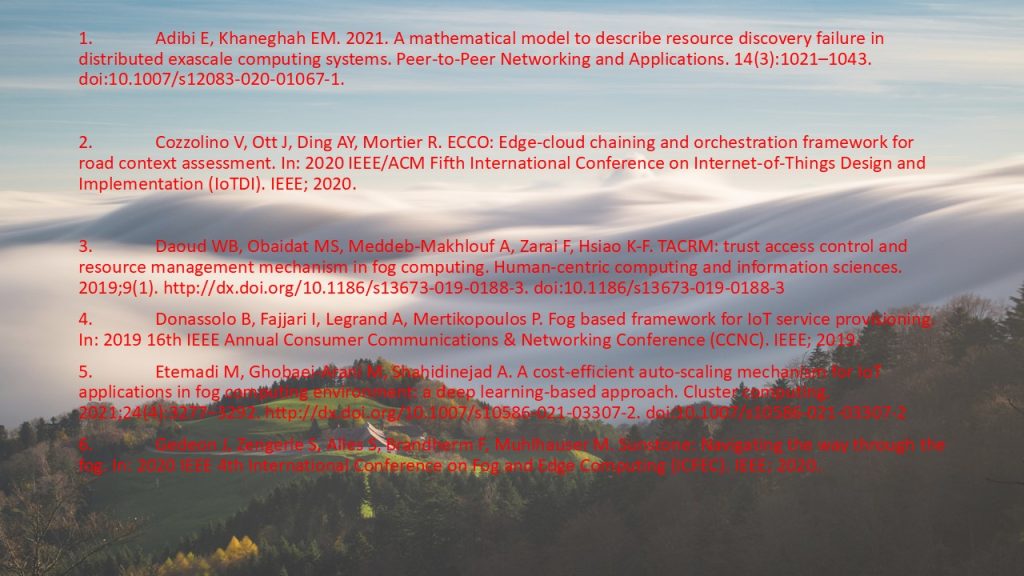
Slide 12
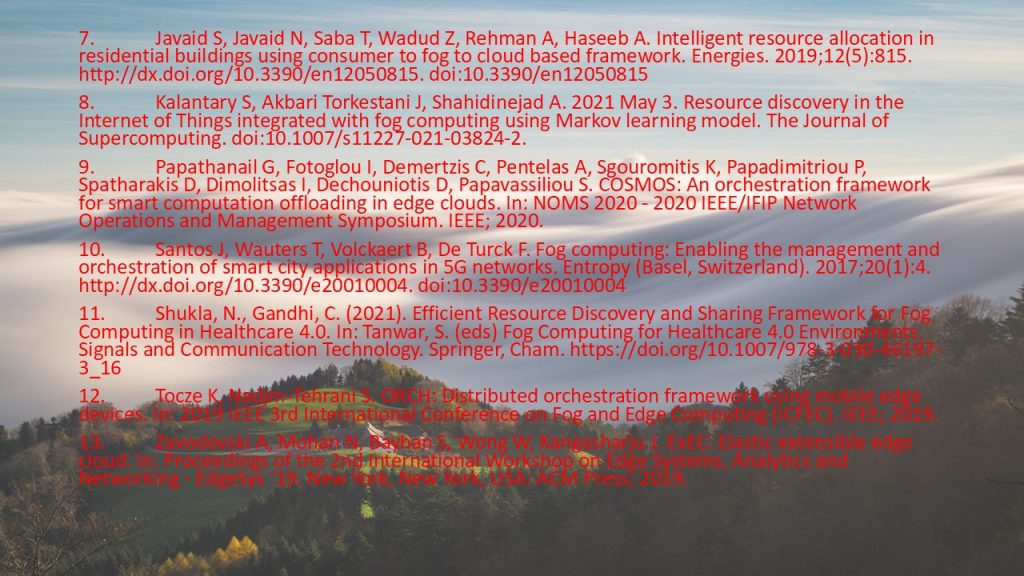
Progress Report
Baseline Resource Discovery in Fog Computing in Real World Environment Progress Report
Old Dominion University
English 231C
Professor Heart
Nov 10th, 2022
Scope and Purpose
Progress in establishing a baseline platform for fog computing resource discovery in real world application is going very well. It is our goal to establish this program to bring a sense of unity in purpose for future development and advancement of the Internet of Things (IOT) and bringing computing resources closer to the end devices. This will allow for quicker and more efficient research and development due to a common footing versus individual groups and organizations purposing various programs which essentially do the same thing. Currently, the project is on target for completion as proposed and will demonstrate real world application for a standardized resource distribution from already existing infrastructure.
Background
The purpose of our project is to develop and display efficient resource distribution from already existing infrastructure in a city environment. There have been many studies conducted for how best to discover and distribute resources in the fog layer of IOT. However, these studies have major limitations in real world applications. Firstly, is that all the studies are computer simulations and no real-world studies have been conducted thus far. Secondly, many studies are conducted with a centralized topological organization. This organization is inaccurate for how resources are currently distributed and has the single point of failure issue to be resolved as well. Lastly, resource discovery needs to be scalable and easily able to find new processing nodes as they come into the system.
Work Completed
Three months ago, we started the project and have completed the baseline set up for data collection and processing. We have spent this time gathering volunteer participants to take part in our study. There are currently 500 volunteers from a diverse demographic to accurately display resources usage for all groups. Five companies have allowed us access to their servers for use in the study to analyze discoverability. The city of Norfolk, Virginia will be serviced by these resource nodes. Our computer programmers have completed the simple applications for our participants to test. These include a location recognition and augmented reality program. The resource discovery program has also been written and uploaded to the participating servers as well.
Problems
Some problems have arisen during the project, but they did not result in any significant delays of the overall project. One of the programming staff in charge of development for the participant applications had a medical issue which left them unable to work for a week. This resulted in a minor delay in development but has not affected the initiation of data collection. Securing the use of company servers also took two weeks longer to complete than anticipated. This was due to delays in company responses to our proposals. Again, this does not affect the starting date of data collection.
Work Scheduled
With all the resources and programs set up and in place we are ready to begin the data collection process over the next two months. The beginning date had been designated for next Monday and midnight. After our two-month data collection process will begin the final month of data processing and analysis. Of course, during the data collection phase we will also be processing and sorting data for easier analysis when the time comes. As it stands now there are no delays and work is on track to be completed as proposed.
Proposal
Research Proposal: Proposal to establish baseline resource discover in fog computing in real world environment
Old Dominion University
ENGL 231C
Professor Heart
October 31, 2022
Proposal to establish baseline resource discover in fog computing in real world environment
Introduction
The Fog Computing paradigm although relatively new has had significant research and development into the best effective way to manage and secure it. It is also the nature of its immaturity that there is no consensus or starting point to base research of off. Researchers each focus on a specific goal or proposing novel approaches in simulations towards the design and building of a strong and secure system without the loss of performance for fog-based networking [3]. Therefore, a standardized platform or structure should be established in a live environment so future works can be performed more efficiently.
Background
The Internet of Things (IOT) is a continually growing physical and digital hybrid environment with end devices being connected to the Internet. The IOT is generally placed in a three-tiered organization starting with the end user, the middle layer as the fog layer, and the cloud layer. It is already known that the cloud layer has strong computing processes but is limited in terms of latency and is not ideal for time-sensitive processing [5]. Therefore, the fog layer has been developed in recent years to bring resources closer to the end user [13] and resolving the latency issues very efficiently [7].
Many authors have tested a simulated centralized organization of the fog layer. In this type of organization one node is deemed the leader and make decisions based on the overall dynamics of the system at the time. This system is ideal for testing in a controlled environment and makes resource management simpler [2,4,5,9,10,13]. This set up however is not realistic of how the current world is set up. Also, not all nodes know of or can discover one another or adapt resources on a global scale.
Objective
Many studies on discovering fog-based resources have only been tested through simulation [5]. The resource discovery process with regards to fog-based resources is a challenge to process and analyze the data that the resources need to be efficiently indexed, ranked, and stored [8]. Our proposal is to create and run a resource discovery program in a live dynamic environment to establish the platform for standardization of resource discover in the fog computing paradigm using a Peer-to-Peer (P2P) network overlay of fog nodes.
Rationale
Testing simulations are an important step in the research process as they can give an indication of the proposed efficacy of the writer. However, they do not all necessarily consider the ability to deploy applications to highly heterogenous devices or the interplay of all the layers [2]. The dynamic events of the environment and variability of computing elements outside of the system can lead to failure of resource discovery [1]. We will build upon already established works that have been shown through simulations to be effective and bring a unifying method that will work effectively to discover fog computing resources in a dynamic environment. This will allow for much needed standardization in the fog computing paradigm and bring scientists together for consensus and focus.
Methodology
We propose a distributed based organization methodology to this problem. First, we shall utilize a P2P overlay for fog nodes to discover and remember one another. Then we will create simple applications for various high computation and time sensitive requests. These would include augmented reality and point of interest recognition [6,9,12] that volunteer participants would use.
To test the efficacy of discovery and quality of service for the end users in live environments we would use already established fog-based infrastructure from various company holders. This would be limited to the area of a city in which testing participants would go about their average daily activities. We will monitor various factors to include latency times, task completion rates, fog node task loading, and network usage. We would also remove or add servers throughout the testing time to simulate the addition or removal of resources that would potentially happen in a real-world environment. These real-world additions or removals could possible be due to power outages, a node leaving the area, or new nodes coming into the area.
Utilizing a P2P network overlay on already established infrastructure will allow the network to self-organize, share resources, distribute resources, distribute control, and symmetric communication [11]. This approach will allow for better scalability as the system demands, reduces the risk for single points of failure, and allow easier discovery of new resources.
Dates/Budget
We propose a 6-month timeframe for our project and $250,000. The first month to create the various programs to be distributed to our volunteer participants for use. The next month would be to find and establish a network of fog nodes that are already established throughout the city of choice. The first to third months would be also spent finding participants for our project. The fourth and fifth months would be devoted to the actual collection of data on our programing and how users are using their given applications. At this point we would also begin adding or removing servers at random intervals as well. The final and sixth month would be dedicated towards processing and analyzing that data that was collected.
Our budget of $250,000 dollars would be dedicated as follows:
$150,000 staffing salary
$50,000 company compensation for use of their servers
$25,000 programming software
$25,000 participant compensation
Conclusion
The efforts of this research will benefit all future endeavors for fog-based resource discovery and development. This will do so by providing a standardized platform for resource discovery among an everchanging environment. It will also give first evidence in an open and dynamic environment to provide real world data for others to use. This will allow other scientists to have a head start on their research when considering real world applications.
References
1. Adibi E, Khaneghah EM. 2021. A mathematical model to describe resource discovery failure in distributed exascale computing systems. Peer-to-Peer Networking and Applications. 14(3):1021–1043. doi:10.1007/s12083-020-01067-1.
2. Cozzolino V, Ott J, Ding AY, Mortier R. ECCO: Edge-cloud chaining and orchestration framework for road context assessment. In: 2020 IEEE/ACM Fifth International Conference on Internet-of-Things Design and Implementation (IoTDI). IEEE; 2020.
3. Daoud WB, Obaidat MS, Meddeb-Makhlouf A, Zarai F, Hsiao K-F. TACRM: trust access control and resource management mechanism in fog computing. Human-centric computing and information sciences. 2019;9(1). http://dx.doi.org/10.1186/s13673-019-0188-3. doi:10.1186/s13673-019-0188-3
4. Donassolo B, Fajjari I, Legrand A, Mertikopoulos P. Fog based framework for IoT service provisioning. In: 2019 16th IEEE Annual Consumer Communications & Networking Conference (CCNC). IEEE; 2019.
5. Etemadi M, Ghobaei-Arani M, Shahidinejad A. A cost-efficient auto-scaling mechanism for IoT applications in fog computing environment: a deep learning-based approach. Cluster computing. 2021;24(4):3277–3292. http://dx.doi.org/10.1007/s10586-021-03307-2. doi:10.1007/s10586-021-03307-2
6. Gedeon J, Zengerle S, Alles S, Brandherm F, Muhlhauser M. Sunstone: Navigating the way through the fog. In: 2020 IEEE 4th International Conference on Fog and Edge Computing (ICFEC). IEEE; 2020.
7. Javaid S, Javaid N, Saba T, Wadud Z, Rehman A, Haseeb A. Intelligent resource allocation in residential buildings using consumer to fog to cloud based framework. Energies. 2019;12(5):815. http://dx.doi.org/10.3390/en12050815. doi:10.3390/en12050815
8. Kalantary S, Akbari Torkestani J, Shahidinejad A. 2021 May 3. Resource discovery in the Internet of Things integrated with fog computing using Markov learning model. The Journal of Supercomputing. doi:10.1007/s11227-021-03824-2.
9. Papathanail G, Fotoglou I, Demertzis C, Pentelas A, Sgouromitis K, Papadimitriou P, Spatharakis D, Dimolitsas I, Dechouniotis D, Papavassiliou S. COSMOS: An orchestration framework for smart computation offloading in edge clouds. In: NOMS 2020 – 2020 IEEE/IFIP Network Operations and Management Symposium. IEEE; 2020.
10. Santos J, Wauters T, Volckaert B, De Turck F. Fog computing: Enabling the management and orchestration of smart city applications in 5G networks. Entropy (Basel, Switzerland). 2017;20(1):4. http://dx.doi.org/10.3390/e20010004. doi:10.3390/e20010004
11. Shukla, N., Gandhi, C. (2021). Efficient Resource Discovery and Sharing Framework for Fog Computing in Healthcare 4.0. In: Tanwar, S. (eds) Fog Computing for Healthcare 4.0 Environments. Signals and Communication Technology. Springer, Cham. https://doi.org/10.1007/978-3-030-46197-3_16
12. Tocze K, Nadjm-Tehrani S. ORCH: Distributed orchestration framework using mobile edge devices. In: 2019 IEEE 3rd International Conference on Fog and Edge Computing (ICFEC). IEEE; 2019.
13. Zavodovski A, Mohan N, Bayhan S, Wong W, Kangasharju J. ExEC: Elastic extensible edge cloud. In: Proceedings of the 2nd International Workshop on Edge Systems, Analytics and Networking – EdgeSys ’19. New York, New York, USA: ACM Press; 2019.
Review Article
Review Article: Fog Layer Organization
Old Dominion University
ENGL 231C
Professor Heart
October 12, 2022
Introduction
In recent years, an increasing number of devices are being interconnected with each other and to the internet, this has come to be known as the Internet of Things (IOT). The IOT is also connected to Cloud based servers for various computational tasks and applications. The difficulties that come with Cloud processing are high latency, inefficient processing, and ineffective resource management [4]. To address these deficiencies, the fog computing paradigm has been developed to bring resources closer to the end devices [9]. The Fog computing paradigm is a relatively new concept, and the question becomes what is the best way to organize and distribute resources to the end user?
Body
The relationship between user, fog computing, and cloud computing is referred to as a three-tiered layer. The bottom layer IOT as the end user, the middle layer as the fog layer which processes requests close to the end user, and the cloud layer. With the advantages of bringing resources closer to the end-user, there also comes several challenges with it due to fog nodes having limited resources [2] and how to efficiently deploy application with highly heterogenous devices [1]. Moreover, it is not about only fog or cloud layer computing but the important idea for development is in their interplay [1].
Many authors have written about fog layer processing and how to organize the topology for best results with low latency, high quality of service (QOS), high energy efficiency, and scalability. Three layers are discussed in the articles first a centralized approach, with and central node as the controller; second is a decentralized approach, with a group of nodes having a local leader and the leaders communicate and make decision. Lastly a distributed approach, with all fog nodes communicating and making decisions with the whole infrastructure in mind.
Most of the authors reviewed, 7 out of 10 (1, 3, 4, 6, 7, 8,10), discuss a centralized approach to their organization for the fog layer. In this dynamic one Fog Node is deemed the leader and makes decisions based overall on the dynamics at the time. This presentation has advantages with processes like resource management becoming simpler [1, 3, 4, 7, 8, 10].
The centralized approach can lead to a design problem. The use of only one controller begins the issue of a single point of failure. In a circumstance like this if the controller node were to go down due to cyber-attack, hardware malfunction, or power loss then the serviced area would go down as well and cause frustration for the user. Therefore, the design and building of a strong and secure system without the loss of performance is a primary challenge for fog-based networking [2].
Daud et al. propose a decentralized organization to the fog layer with an added security mechanism. Their proposed strategy is based on a trust estimation of user’s behaviors using machine learning algorithms. This assigns a trust value to a user and monitors the environment for abnormal activity which may be associated with cyber attacks which are usually due to inefficient and insufficient resource policies and monitoring. Daud et al. simulations of their proposal significant improvements in latency with high trustworthiness.
Even with a decentralized organization there still exists a challenge of flexibility regarding quick changes of load surges. [9] defines this load surge as a problem with increased task arrival and where to place them. Thus, they propose a distributed organization made up of both stationary and mobile edge devices to address sudden load changes while keeping resource costs low with high quality of service. This is due to the ability of each edge device to place a task it receives without having to change to local infrastructure [9]. In doing so, under computer simulations, this set up was able to surpass stationary or scheduled models in terms of task completion. Thus, showing the importance of mobility in resource management especially with regards to delay sensitive traffic like augmented reality.
Despite cloud computing providing slow resources and fog computing resolving those issues very efficiently [6], their still exists the issue of discovering said fog resources [5]. With all the previous topologies mentioned they are still isolated services on a global scale. [5] and [10] have identified this same issue and proposed a similar domain name system (DNS) based discovery for fog resources. The utilization of DNS for discover eliminates the problem of a centralized catalog management and ownership [10]. This is due to the centralized reference architecture does not match with today’s reality where all parties would know information on all fog sites [5].
Conclusion
In this review we have discussed what the Fog computing paradigm is and the benefits of it for the IOT with reduced latency and decreased resource costs. However, due to its relatively immature nature, there is a lack of consensus on the best way to implement such technology. Each article reviewed for this paper has a distinct perspective and goal for their proposed organization. This causes a diverse number of solutions without a built foundation. As more solutions are developed for increasing the efficacy of the fog computing paradigm, with it grows the increasing need for standardization and reference.
References
- Cozzolino V, Ott J, Ding AY, Mortier R. ECCO: Edge-cloud chaining and orchestration framework for road context assessment. In: 2020 IEEE/ACM Fifth International Conference on Internet-of-Things Design and Implementation (IoTDI). IEEE; 2020.
- Daoud WB, Obaidat MS, Meddeb-Makhlouf A, Zarai F, Hsiao K-F. TACRM: trust access control and resource management mechanism in fog computing. Human-centric computing and information sciences. 2019;9(1). http://dx.doi.org/10.1186/s13673-019-0188-3. doi:10.1186/s13673-019-0188-3
- Donassolo B, Fajjari I, Legrand A, Mertikopoulos P. Fog based framework for IoT service provisioning. In: 2019 16th IEEE Annual Consumer Communications & Networking Conference (CCNC). IEEE; 2019.
- Etemadi M, Ghobaei-Arani M, Shahidinejad A. A cost-efficient auto-scaling mechanism for IoT applications in fog computing environment: a deep learning-based approach. Cluster computing. 2021;24(4):3277–3292. http://dx.doi.org/10.1007/s10586-021-03307-2. doi:10.1007/s10586-021-03307-2
- Gedeon J, Zengerle S, Alles S, Brandherm F, Muhlhauser M. Sunstone: Navigating the way through the fog. In: 2020 IEEE 4th International Conference on Fog and Edge Computing (ICFEC). IEEE; 2020.
- Javaid S, Javaid N, Saba T, Wadud Z, Rehman A, Haseeb A. Intelligent resource allocation in residential buildings using consumer to fog to cloud based framework. Energies. 2019;12(5):815. http://dx.doi.org/10.3390/en12050815. doi:10.3390/en12050815
- Papathanail G, Fotoglou I, Demertzis C, Pentelas A, Sgouromitis K, Papadimitriou P, Spatharakis D, Dimolitsas I, Dechouniotis D, Papavassiliou S. COSMOS: An orchestration framework for smart computation offloading in edge clouds. In: NOMS 2020 – 2020 IEEE/IFIP Network Operations and Management Symposium. IEEE; 2020.
- Santos J, Wauters T, Volckaert B, De Turck F. Fog computing: Enabling the management and orchestration of smart city applications in 5G networks. Entropy (Basel, Switzerland). 2017;20(1):4. http://dx.doi.org/10.3390/e20010004. doi:10.3390/e20010004
- Tocze K, Nadjm-Tehrani S. ORCH: Distributed orchestration framework using mobile edge devices. In: 2019 IEEE 3rd International Conference on Fog and Edge Computing (ICFEC). IEEE; 2019.
- Zavodovski A, Mohan N, Bayhan S, Wong W, Kangasharju J. ExEC: Elastic extensible edge cloud. In: Proceedings of the 2nd International Workshop on Edge Systems, Analytics and Networking – EdgeSys ’19. New York, New York, USA: ACM Press; 2019.
Writing & Science: Your History Essay
I Write Because It Is Necessary
Old Dominion University
ENGL 231C
Professor Hear
9/9/2022
Writing is essential to my work as a student because it is the main method to convey and receive information and understanding of a specific topic. This is especially important in an online setting when other methods for communicating are not available. Usually, in a lecture setting there is a significant amount of verbal and bodily exchange that is not present in an online discussion. Teachers, in lecture, are also quicker at adjusting their explanations to reach a student who is not understanding a topic. Verbal tone and body language is also lost in an online setting as well. This then places even more burden on well written and clearly understandable writing for the student to both receive and express their information.
I am not currently a research scientist, nor do I plan to be in the future, but it is still important for me to be up to date with the current research so that I can perform my current job and future jobs better. I am currently a Licensed Physical Therapist Assistant who specializes in a new manual technique called Fascial Counterstrain. Since this technique is new, I receive a lot of resistance to the initial idea of this method from those who are new to the experience. Having read and studied a large amount of the supporting anatomical and physiological research it has prepared me to better understand the methodology of the technique and express it in a way that both patients and fellow therapists are willing to accept.
When I look back at the time I was in class to becoming a Physical Therapist Assistant I did not realize the importance of writing and my soon to be job. I like all my peers were trying to just digest as much information as possible to regurgitate it later for board exams to get our licenses. Fortunately, our teachers did a really good job of getting us to drink from the fire hydrant of information and our entire class was able to pass on our first try. We were only able to pass because of clear writing from researchers and teachers alike. Due to a good understanding of the material we all could accurately and rationally express our knowledge during our school experience.
Part of this experience was a group project to research and do a formal presentation on a subject related to the field. My groups research topic was on the rotator cuff of the shoulder and how to treat it in a clinical setting. This led the group into doing a lot of research on the shoulder anatomy, its surgeries, and even bringing in a volunteer to treat on campus. As a result, we all became very knowledgeable of how the shoulder works and how we can restore it to normal function. This growth of knowledge and understanding would not have happened if it had not been for the in-depth self-studying we performed. To this day I am still one of the top therapists to see for shoulder rehabilitation in my clinic due to my development in writing about the shoulder.
Looking towards the future as a cybersecurity specialist I still do not see myself writing research papers for the community. The challenge of being writer for me will be that I just do not want to do it honestly. I have never had a desire to be a research scientist and explore new ideas that is for others with that type of mindset to explore and create new things or ideas. Knowing me, I am more of an engineer and of an in practical use mindset. I will be the one who implements and performs what researchers prove. I always look for the most direct and efficient way to do things. This even includes writing for me. I always have and will always continue to try and express my thoughts and ideas as quickly and efficiently as possible. With that being said I do, however, see a very real need to read and stay up to date with the current research though. Again, as with my current job, the more I understand about a topic the better prepared I will be to perform job related duties. This is especially important because new technology and processes are being created every day. There are constantly new threats of cybercrime with new viruses, frauds, and malware. The most I can see myself writing in the future would be for administrative reasons of job progress and implementation rationale.